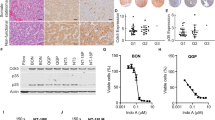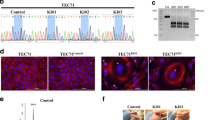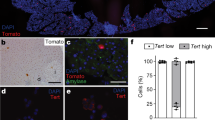Abstract
Thymidylate synthase (TS) is an essential enzyme for DNA synthesis and repair and elevated levels of TS have been identified as an important prognostic biomarker for colorectal cancer and several other common human malignancies. In addition, TS gene expression has been linked with cell-cycle regulation and cell proliferation through the ability of retinoblastoma protein to repress the transcriptional activation of E2F target genes such as TS. Therefore, overproduction of TS could participate in the progression to a neoplastic phenotype. Consistent with this model, a recent study has suggested that ectopic TS expression can induce a transformed phenotype in mammalian cells. To investigate the role of deregulated TS activity in tumor development, we generated transgenic mice that express high levels of catalytically active human TS (hTS) exclusively in the pancreas and low levels of hTS in multiple other tissues. Analyses of pancreatic tissue in TS transgenic mice revealed abnormalities within the endocrine pancreas, ranging from pancreatic islet hyperplasia to the detection of islet cell tumors. Overexpression of hTS in murine islets provides a new model to study genetic alterations associated with the progression from normal cells to hyperplasia to islet cell tumors, and suggests that this mouse model may be useful for regulating TS activity in vivo for development of cancer prevention and new therapies.
This is a preview of subscription content, access via your institution
Access options
Subscribe to this journal
Receive 50 print issues and online access
$259.00 per year
only $5.18 per issue
Buy this article
- Purchase on Springer Link
- Instant access to full article PDF
Prices may be subject to local taxes which are calculated during checkout





Similar content being viewed by others
References
Alexandrova N, Niklinski J, Bliskovsky V, Otterson GA, Blake M, Kaye FJ et al. (1995). The N-terminal domain of c-Myc associates with alpha-tubulin and microtubules in vivo and in vitro. Mol Cell Biol 15: 5188–5195.
Allegra CJ, Paik S, Colangelo LH, Parr AL, Kirsch I, Kim G et al. (2003). Prognostic value of thymidylate synthase, Ki-67, and p53 in patients with Dukes' B and C colon cancer: a National Cancer Institute-National Surgical Adjuvant Breast and Bowel Project collaborative study. J Clin Oncol 21: 241–250.
Almoguera C, Shibata D, Forrester K, Martin J, Arnheim N, Perucho M . (1988). Most human carcinomas of the exocrine pancreas contain mutant c-K-ras genes. Cell 53: 549–554.
Angus SP, Wheeler LJ, Ranmal SA, Zhang X, Markey MP, Mathews CK et al. (2002). Retinoblastoma tumor suppressor targets dNTP metabolism to regulate DNA replication. J Biol Chem 277: 44376–44384.
Banerjee D, Schnieders B, Fu JZ, Adhikari D, Zhao SC, Bertino JR . (1998). Role of E2F-1 in chemosensitivity. Cancer Res 58: 4292–4296.
Bertino JR, Banerjee D . (2003). Is the measurement of thymidylate synthase to determine suitability for treatment with 5-fluoropyrimidines ready for prime time? Clin Cancer Res 9: 1235–1239.
Casanovas O, Hager JH, Chun MG, Hanahan D . (2005). Incomplete inhibition of the Rb tumor suppressor pathway in the context of inactivated p53 is sufficient for pancreatic islet tumorigenesis. Oncogene 24: 6597–6604.
Chu E, Allegra CJ . (1996). Mechanisms of clinical resistance to 5-fluorouracil chemotherapy. Cancer Treat Res 87: 175–195.
Crabtree JS, Scacheri PC, Ward JM, Garrett-Beal L, Emmert-Buck MR, Edgemon KA et al. (2001). A mouse model of multiple endocrine neoplasia, type 1, develops multiple endocrine tumor. Proc Natl Acad Sci USA 98: 1118–1123.
Crabtree JS, Scacheri PC, Ward JM, McNally SR, Swain GP, Montagna C et al. (2003). Of mice and MEN1: Insulinomas in a conditional mouse knockout. Mol Cell Biol 23: 6075–6085.
DeGregori J, Kowalik T, Nevins JR . (1995). Cellular targets for activation by the E2F1 transcription factor include DNA synthesis- and G1/S-regulatory gene. Mol Cell Biol 15: 4215–4224.
Edler D, Hallstrom M, Johnston PG, Magnusson I, Ragnhammar P, Blomgren H . (2000). Thymidylate synthase expression: an independent prognostic factor for local recurrence, distant metastasis, disease-free and overall survival in rectal cancer. Clin Cancer Res 6: 1378–1384.
Franklin DS, Godfrey VL, O'Brien DA, Deng C, Xiong Y . (2000). Functional collaboration between different cyclin-dependent kinase inhibitors suppresses tumor growth with distinct tissue specificity. Mol Cell Biol 20: 6147–6158.
Hanahan D . (1985). Heritable formation of pancreatic beta-cell tumours in transgenic mice expressing recombinant insulin/simian virus 40 oncogenes. Nature 315: 115–122.
Hoeflich A, Wu M, Mohan S, Foll J, Wanke R, Froehlich T et al. (1999). Overexpression of insulin-like growth factor-binding protein-2 in transgenic mice reduces postnatal body weight gain. Endocrinology 140: 5488–5496.
Johnston PG, Drake JC, Steinberg SM, Allegra CJ . (1993). Quantitation of thymidylate synthase in human tumors using an ultrasensitive enzyme-linked immunoassay. Biochem Pharmacol 45: 2483–2486.
Johnston PG, Lenz HJ, Leichman CG, Danenberg KD, Allegra CJ, Danenberg PV et al. (1995). Thymidylate synthase gene and protein expression correlate and are associated with response to 5-fluorouracil in human colorectal and gastric tumors. Cancer Res 55: 1407–1412.
Johnston PG, Mick R, Recant W, Behan KA, Dolan ME, Ratain MJ et al. (1997). Thymidylate synthase expression and response to neoadjuvant chemotherapy in patients with advanced head and neck cancer. J Natl Cancer Inst 89: 308–313.
Lewis BC, Klimstra DS, Varmus HE . (2003). The c-myc and PyMT oncogenes induce different tumor types in a somatic mouse model for pancreatic cancer. Genes Dev 17: 3127–3138.
Martinez A, Pio R, Lopez J, Cuttitta F . (2001). Expression of the adrenomedullin binding protein, complement factor H, in the pancreas and its physiological impact on insulin secretion. J Endocrinol 170: 503–511.
Milne TA, Hughes CM, Lloyd R, Yang Z, Rozenblatt-Rosen O, Dou Y et al. (2005). Menin and MLL cooperatively regulate expression of cyclin-dependent kinase inhibitors. Proc Natl Acad Sci USA 102: 749–754.
Navalgund LG, Rossana C, Muench AJ, Johnson LF . (1980). Cell cycle regulation of thymidylate synthetase gene expression in cultured mouse fibroblast. J Biol Chem 255: 7386–7390.
Pavelic K, Hrascan R, Kapitanovic S, Karapandza N, Vranes Z, Belicza M et al. (1995). Multiple genetic alterations in malignant metastatic insulinomas. J Pathol 177: 395–400.
Pelengaris S, Khan M, Evan GI . 2002). Suppression of Myc-induced apoptosis in beta cells exposes multiple oncogenic properties of Myc and triggers carcinogenic progression. Cell 109: 321–334.
Pestalozzi BC, Peterson HF, Gelber RD, Goldhirsch A, Gusterson BA, Trihia H et al. (1997). Prognostic importance of thymidylate synthase expression in early breast cancer. J Clin Oncol 15: 1923–1931.
Rahman L, Voeller D, Rahman M, Lipkowitz S, Allegra C, Barrett JC et al. (2004). Thymidylate synthase as an oncogene: a novel role for an essential DNA synthesis enzyme. Cancer Cell 5: 341–351.
Rane SG, Cosenza SC, Mettus RV, Reddy EP . (2002). Germ line transmission of the Cdk4(R24C) mutation facilitates tumorigenesis and escape from cellular senescence. Mol Cell Biol 22: 644–656.
Sato T, Konishi K, Kimura H, Maeda K, Yabushita K, Tsuji M et al. (2000). Evaluation of PCNA, p53, K-ras and LOH in endocrine pancreas tumors. Hepatogastroenterology 47: 875–879.
Shintani Y, Ohta M, Hirabayashi H, Tanaka H, Iuchi K, Nakagawa K et al. (2003). New prognostic indicator for non-small-cell lung cancer, quantitation of thymidylate synthase by real-time reverse transcription polymerase chain reaction. Int J Cancer 104: 790–795.
Takimoto CH, Diggikar S . (2005). Thymidylate synthase inhibitors. Cancer Chemother Biol Response Modif 22: 1–18.
Voeller DM, Zajac-Kaye M, Fisher RJ, Allegra CJ . (2002). The identification of thymidylate synthase peptide domains located in the interface region that bind thymidylate synthase mRNA. Biophys Res Commun Biochem 297: 24–31.
Wang EH, Ebrahimi SA, Wu AY, Kashefi C, Passaro Jr E, Sawicki MP . (1998). Mutation of the MENIN gene in sporadic pancreatic endocrine tumors. Cancer Res 58: 4417–4420.
Williams BO, Remington L, Albert DM, Mukai S, Bronson RT, Jacks T . (1994). Cooperative tumorigenic effects of germline mutations in Rb and p53. Nat Genet 7: 480–484.
Yang SX, Simon RM, Tan AR, Nguyen D, Swain SM . (2005). Gene expression patterns and profile changes pre- and post-erlotinib treatment in patients with metastatic breast cancer. Clin Cancer Res 11: 6226–6232.
Zhan Y, Brady JL, Johnston AM, Lew AM . (2000). Predominant transgene expression in exocrine pancreas directed by the CMV promoter DNA. Cell Biol 19: 639–645.
Acknowledgements
We thank Alfredo Martinez for help with islet cells isolation, Steve Jay for help with the animals and Philip Martin for helpful discussions. This research was supported by the Intramural Research Program of the NIH, National Cancer Institute, Center for Cancer Research and has complied with all relevant federal guidelines and NIH policies.
Author information
Authors and Affiliations
Corresponding author
Rights and permissions
About this article
Cite this article
Chen, M., Rahman, L., Voeller, D. et al. Transgenic expression of human thymidylate synthase accelerates the development of hyperplasia and tumors in the endocrine pancreas. Oncogene 26, 4817–4824 (2007). https://doi.org/10.1038/sj.onc.1210273
Received:
Revised:
Accepted:
Published:
Issue Date:
DOI: https://doi.org/10.1038/sj.onc.1210273
Keywords
This article is cited by
-
TYMS promotes genomic instability and tumor progression in Ink4a/Arf null background
Oncogene (2023)
-
Ribonucleotide reductase small subunit p53R2 suppresses MEK–ERK activity by binding to ERK kinase 2
Oncogene (2009)
-
Effects of small interfering RNA targeting thymidylate synthase on survival of ACC3 cells from salivary adenoid cystic carcinoma
BMC Cancer (2008)



